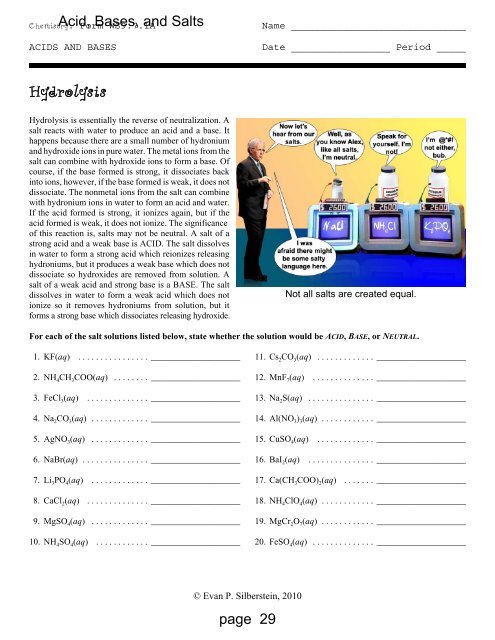Acid Base packet
Acid Base packet
Acid Base packet
Create successful ePaper yourself
Turn your PDF publications into a flip-book with our unique Google optimized e-Paper software.
<strong>Acid</strong>, <strong>Base</strong>s, and Salts<br />
Chemistry: Form WS9.7.1A Name ______________________________<br />
ACIDS AND BASES Date _________________ Period _____<br />
Hydrolysis<br />
Hydrolysis is essentially the reverse of neutralization. A<br />
salt reacts with water to produce an acid and a base. It<br />
happens because there are a small number of hydronium<br />
and hydroxide ions in pure water. The metal ions from the<br />
salt can combine with hydroxide ions to form a base. Of<br />
course, if the base formed is strong, it dissociates back<br />
into ions, however, if the base formed is weak, it does not<br />
dissociate. The nonmetal ions from the salt can combine<br />
with hydronium ions in water to form an acid and water.<br />
If the acid formed is strong, it ionizes again, but if the<br />
acid formed is weak, it does not ionize. The significance<br />
of this reaction is, salts may not be neutral. A salt of a<br />
strong acid and a weak base is ACID. The salt dissolves<br />
in water to form a strong acid which reionizes releasing<br />
hydroniums, but it produces a weak base which does not<br />
dissociate so hydroxides are removed from solution. A<br />
salt of a weak acid and strong base is a BASE. The salt<br />
dissolves in water to form a weak acid which does not<br />
ionize so it removes hydroniums from solution, but it<br />
forms a strong base which dissociates releasing hydroxide.<br />
For each of the salt solutions listed below, state whether the solution would be ACID, BASE, or NEUTRAL.<br />
1. KF(aq) ................ ____________________<br />
2. NH 4CH 3COO(aq) ........ ____________________<br />
3. FeCl 3(aq) .............. ____________________<br />
4. Na 2CO 3(aq) ............. ____________________<br />
5. AgNO 3(aq) ............. ____________________<br />
6. NaBr(aq) ............... ____________________<br />
7. Li 3PO 4(aq) ............. ____________________<br />
8. CaCl 2(aq) .............. ____________________<br />
9. MgSO 4(aq) ............. ____________________<br />
10. NH 4SO 4(aq) ............ ____________________<br />
© Evan P. Silberstein, 2010<br />
page 29<br />
Not all salts are created equal.<br />
11. Cs 2CO 3(aq) ............. ____________________<br />
12. MnF 7(aq) .............. ____________________<br />
13. Na 2S(aq) ............... ____________________<br />
14. Al(NO 3) 3(aq) ............ ____________________<br />
15. CuSO 4(aq) ............. ____________________<br />
16. BaI 2(aq) ............... ____________________<br />
17. Ca(CH 3COO) 2(aq) ....... ____________________<br />
18. NH 4ClO 4(aq) ............ ____________________<br />
19. MgCr 2O 7(aq) ............ ____________________<br />
20. FeSO 4(aq) .............. ____________________

















